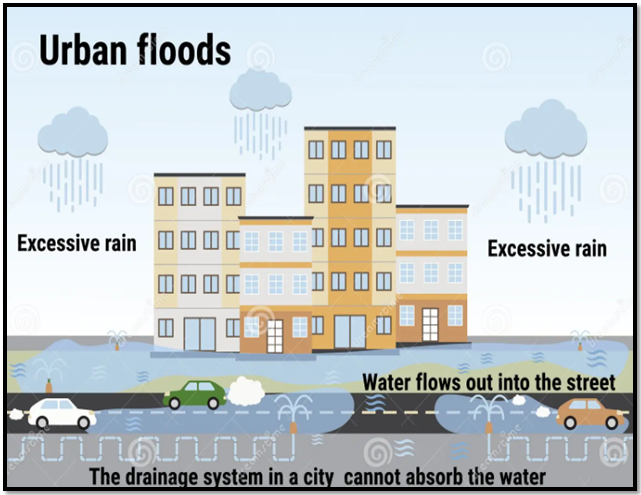WHEN THE CLOUDS GATHER
Syllabus:
GS 3:
- Disaster and Disaster Management
- Environment and Degradation
Why in the News?
Heavy rains in Delhi and NCR caused severe flooding, traffic paralysis, and fatalities, highlighting poor civic maintenance, aging infrastructure, and the failure to integrate urban planning with climate change adaptations.
Source: Dreamstime
Introduction
- Heavy rains frequently inundate Indian cities like Delhi and adjoining NCR, paralyzing traffic and causing fatalities.
- This recurring issue raises a crucial question: Why are Indian cities unprepared for the monsoon?
- A major factor lies in the inadequate drainage systems.
- While ancient civilizations like the Indus Valley had effective water management techniques, modern urban planning often neglects such wisdom.
- The proliferation of concrete surfaces increases runoff problems, leading to flooding in low-lying areas.
- Urban India’s struggle with intense rainfall highlights the urgent need for improved infrastructure to cope with climate change-induced weather patterns.
| Hyper-Local Torrential Rainfall
Hyper-local torrential rainfall involves extremely heavy rain concentrated in a specific area over a short time. This localized phenomenon is often unexpected and can have severe impacts. Impact
Causes
|
The Impact of Hyper-Local Torrential Rainfall
Increasing Intensity of Rainfall
- Climate change has led to an increase in hyper-local torrential rainfall, making urban areas highly vulnerable.
- On July 26, Delhi’s ridge area recorded 99 mm of rainfall, while nearby Pusa saw 58 mm a day later. (the IMD considers 64 mm as heavy rainfall.)
Inadequate Infrastructure
- Delhi’s drainage system, which is nearly 50 years old, struggles with even 50 mm of rain.
- This outdated infrastructure is ill-equipped to manage the volume of water, leading to severe flooding.
Tragic Incidents
- A drain burst led to the death of three young individuals in Old Rajinder Nagar.
- Additionally, UPSC aspirant Nilesh Rai was electrocuted while attempting to navigate a waterlogged street.
- Another incident near the IFFCO metro station in Gurugram claimed three lives due to high-tension wires contacting the floodwater.
Urban Planning and Drainage Challenges
Historical Urban Layout
- Historically, Delhi’s past cities were positioned on elevated terrain, facilitating natural water drainage.
- This geographical advantage allowed for effective water management.
Modern Planning Issues
- Contemporary urban planning in Delhi, characterized by radial and block patterns, often neglects the city’s natural contours.
- This lack of alignment with natural inclines disrupts the effective flow of runoff.
Specific Problem Areas
- Key areas like the Minto underpass, located in a depression surrounded by higher ground, are particularly vulnerable.
- On recent occasions, such as Wednesday, these depressions become overwhelmed, leading to significant flooding in Old Rajinder Nagar and similar locations.
Hydrological Neglect Across Indian Cities
Geological Diversity
- Indian cities like Delhi, Mumbai, and Bengaluru, each with distinct geological features, face similar water-related challenges due to a disregard for hydrology.
Mumbai’s Vulnerabilities
- Mumbai’s topography, altered by hill flattening and land reclamation since colonial times, creates a mix of low-lying and elevated areas.
- This leads to significant flooding during rains, with high tides exacerbating the problem.
Impact on Infrastructure
- During the monsoon, flooding disrupts Mumbai’s essential railway system, and the city increasingly experiences prolonged weather-related disruptions following the 2005 floods.
Disproportionate Impact of Climate Change on Urban Poor
- Unequal Effects: Climate change increases the impact of floods, heatwaves, and extreme weather, disproportionately affecting the poor and lower-middle classes.
- Neglect in Infrastructure: Urban development in India often overlooks informal settlements like slums, despite their political significance.
- Drainage Issues: Waste from these unrecognized areas clogs stormwater drains, leading to severe flooding during heavy rains.
- Disease outbreaks: This results in disease outbreaks and disruptions to livelihoods in these marginalized communities.
Failures in Urban Planning and Policy
- Tragic Incidents: The coaching centre tragedy and Nilesh Rai’s death highlight the shortcomings in urban planning and policymaking.
- Historical Context: Rajinder Nagar and its surrounding areas, initially developed as Partition refugee settlements, now include middle-class homes, student tenements, and slums, reflecting a neglected socio-economic divide in Delhi’s urban landscape.
Historical vs. Modern Drainage in Delhi
- Historical Water Management: In pre-modern Delhi, rivulets and streams from the Aravallis efficiently drained stormwater, keeping the city dry after heavy rainfall.
- Current Issues: These water courses have been either developed over or converted into ‘ganda nallahs.’ For example, the Jarhallia Nallah in Karol Bagh has been covered, losing its original drainage function.
Decline in Urban Drainage Systems
Outdated Infrastructure
- Delhi’s drainage system, established in 1976, and Mumbai’s century-old network suffer from neglect.
- These systems, originally built to manage water efficiently, are now outdated.
Gurugram’s Drainage Issues
- Gurugram, despite its “Millennium City” status, faces severe drainage problems.
- The Badshahpur drain overflows during heavy rains, disrupting natural water flows.
Environmental Impact
- Gurugram’s sewage, carried by the Badshahpur drain, is discharged into Delhi’s Najafgarh nallah.
- This nallah, historically linked to the Sahibi river and Indus civilization remnants, suffers from pollution and environmental degradation.
Urgent Need for Comprehensive Urban Planning
- Post-Tragedy Discussions: Following the coaching centre tragedy, discussions on regulating commercial buildings, improving urban infrastructure, and desilting drains have gained momentum.
- Call for Holistic Planning: Planners must integrate drainage systems, hydrology, climate change impacts, and urban mobility dynamics to address inequities and enhance resilience.
- Comprehensive strategies are crucial for effective urban management and disaster prevention.
Conclusion
To address urban flooding effectively, policymakers must integrate modern drainage systems with historical hydrological insights, adapt infrastructure to climate change, and prioritize equitable development.
Source:The Indian Express
Mains Practice Question:
Discuss the multifaceted challenges faced by Indian cities in managing monsoon-related floods, how can policymakers address these challenges to improve resilience against extreme weather events in the future?
Associated Article:




